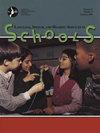填空:匹配双语群体中英语词法的产生。
IF 2.9
3区 医学
Q1 AUDIOLOGY & SPEECH-LANGUAGE PATHOLOGY
Language Speech and Hearing Services in Schools
Pub Date : 2025-04-24
DOI:10.1044/2025_lshss-24-00129
引用次数: 0
摘要
目的比较在家说西班牙语和越南语的双语学龄儿童的英语语法表现,重点研究他们的母语对13种英语语法形式习得的影响。方法对30名儿童完成完形填空任务的得分进行准确性、发展模式和错误类型的分析。两两配对用于越南语和西班牙语双语者的年龄和英语经验的配对。护理人员评估了语言能力和日常使用母语和英语的情况。结果各组中较高的语法准确性与年龄和较高的照顾者对儿童语言能力的评价有关。各组在某些语法形式上表现出相似的模式(例如,复数比不规则过去时的准确性更高),这与先前报道的单语英语儿童的发展模式一致。其他模式的差异与母语影响有关。例如,越南语的语音限制(例如,没有词尾/s/)导致英语形式需要这些声音的准确性较低。结论双语者的英语语法表现既反映了一般发展模式,也反映了母语影响。由于双语儿童可能依赖于母语特定的语言线索,课堂教学可以调整为更符合文化和语言的反应。本文章由计算机程序翻译,如有差异,请以英文原文为准。
Fill in the Blank: English Morphosyntax Production in Matched Bilingual Groups.
PURPOSE
This study compared English grammatical performance of bilingual school-age children who spoke either Spanish or Vietnamese at home, focusing on their first-language influence on the acquisition of 13 English grammatical forms.
METHOD
Scores from 30 children on a cloze task were analyzed for accuracy, developmental patterns, and error types. Pairwise matching was used to match individual Vietnamese and Spanish bilinguals on age and English experience. Caregivers rated language ability and daily use of the home language and English.
RESULTS
Higher grammatical accuracy across groups was associated with older age and higher caregiver ratings of children's language ability. Groups showed similar patterns on some grammatical forms (e.g., higher accuracy on plurals than irregular past), consistent with previously reported developmental patterns of monolingual English-speaking children. Differences in other patterns were related to first-language influence. For example, phonological constraints of Vietnamese (e.g., no word-final /s/), led to lower accuracy in English forms requiring such sounds.
CONCLUSIONS
English grammatical performance in bilinguals can reflect both general developmental patterns and first-language influence. As bilingual children may rely on linguistic cues specific to their first language, classroom instruction can be adjusted to be more culturally and linguistically responsive.
求助全文
通过发布文献求助,成功后即可免费获取论文全文。
去求助
来源期刊

Language Speech and Hearing Services in Schools
Social Sciences-Linguistics and Language
CiteScore
4.40
自引率
12.50%
发文量
165
期刊介绍:
Mission: LSHSS publishes peer-reviewed research and other scholarly articles pertaining to the practice of audiology and speech-language pathology in the schools, focusing on children and adolescents. The journal is an international outlet for clinical research and is designed to promote development and analysis of approaches concerning the delivery of services to the school-aged population. LSHSS seeks to advance evidence-based practice by disseminating the results of new studies as well as providing a forum for critical reviews and meta-analyses of previously published work.
Scope: The broad field of audiology and speech-language pathology as practiced in schools, including aural rehabilitation; augmentative and alternative communication; childhood apraxia of speech; classroom acoustics; cognitive impairment; craniofacial disorders; fluency disorders; hearing-assistive technology; language disorders; literacy disorders including reading, writing, and spelling; motor speech disorders; speech sound disorders; swallowing, dysphagia, and feeding disorders; voice disorders.
 求助内容:
求助内容: 应助结果提醒方式:
应助结果提醒方式:


